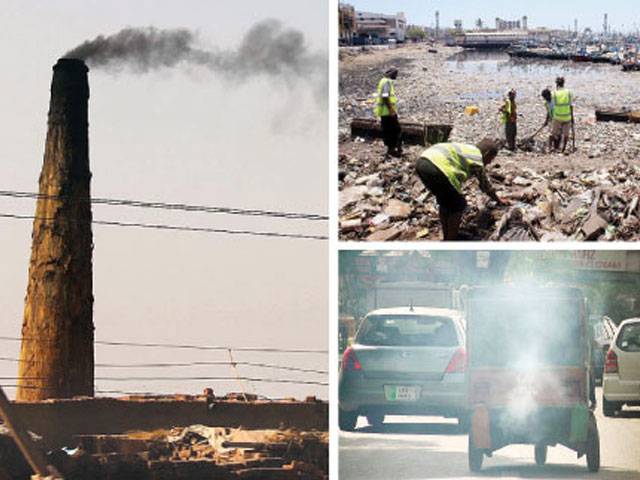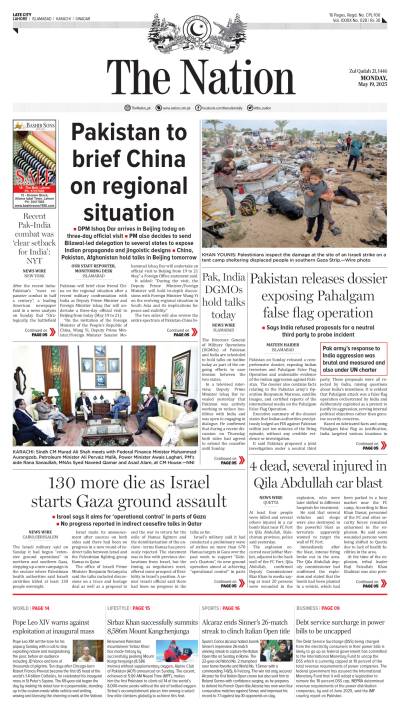LAHORE - The nation is observing another World Environment Day on Wednesday (today), but the authorities in the polluted country are taking least interest in tackling the situation.
Like the previous year, events such as seminars and walks are on the cards at public and private level as a standard ritual that somehow skirts the real issue. Devising a concrete plan to control the ever-increasing pollution has remained ever so elusive, making the life of a common man miserable.
We specialise in every form of it – air pollution from moving and stationary sources; noise pollution from factories and smoky vehicles; and water pollution from raw sewage, industrial wastes and agricultural runoff, to name a few. These all pose a serious threat to life, a battle we all fight without a clear roadmap to survival, let alone victory.
Deforestation, soil erosion and desertification add insult. But instead of giving due attention to the growing problem, state institutions continue wasting resources on stereotypical methods (named above) to highlight environment-related issues. Addressing the problem practically has never appeared to be a serious concern.
The level of pollution in Pakistan’s major cities of Lahore, Karachi and Peshawar is higher than the permissible limits. Lahore, for instance, has topped the list of most polluted cities, with highest air pollution level of 121.85 micrograms per cubic meter that is three times higher than the safe standards, according to the Pakistan Environment Agency (Pak-EPA) statistics.
We are daily breathing polluted air. This has become a cause of concern as a large number of people, particularly children, are contracting lungs and related diseases. The problem is solvable, yet it is unfortunate that neither the people nor the government pay any attention to it.
The National Conservation Strategy Report has documented solid and liquid waste as a major source of water pollution in the country and the cause of widespread waterborne diseases.
As only over half of urban residents have access to sanitation, the remaining urban waste ends up on the roadsides, into waterways, or is incorporated into solid waste. Additionally, only three major sewage treatment plants exist in the country; two of them operate intermittently. Much of the untreated sewage goes into the irrigation system, where the wastewater is reused, and into streams and rivers, which become sewage carriers in low-flow periods. Consequently, the vegetables grown from such wastewater have serious bacteriological contamination. Gastroenteritis, widely considered in medical circles to be the leading cause of death in Pakistan, is transmitted through waterborne pollutants.
Low-lying land is generally used for solid waste disposal, without the benefit of sanitary landfill methods. The National Conservation Strategy has raised concerns about industrial toxic wastes also being dumped in municipal disposal areas without any record of their location, quantity, or toxic composition. Another important issue is the contamination of shallow groundwater near urban industries that discharge wastes directly into the ground.
In most cities, there are no controls on vehicular emissions, which account for 90 percent of air pollution. The National Conservation Strategy Report claims that an average Pakistani vehicle emits 25 times as much carbon monoxide, 20 times as many hydrocarbons, and more than three and one-half times as much nitrous oxide in grams per kilometer as the average vehicle in the United States.
Another major source of pollution, not mentioned in the National Conservation Strategy Report, is noise. The hyper-urbanisation experienced by Pakistan since the 1960s has resulted in loose controls for heavy equipment operation in densely populated areas, as well as in crowded streets filled with buses, trucks, automobiles, and motorcycles, which often honk at each other and at the horse-drawn tongas (used for transporting people) and the horse-drawn rehras (used for transporting goods).
Researchers at the Pakistan Medical Research Council recognise that a large proportion of diseases in Pakistan are caused by the consumption of polluted water. Even the 38 percent of the population that receives water through pipelines runs the risk of consuming seriously contaminated water, although the problem varies by area. In Punjab, for example, as much as 90 percent of drinking water comes from groundwater, as compared with only 9 percent in Sindh.
The federal government's Perspective Plan (1988–2003) and previous five-year plans do not mention sustainable development strategies. Further, there have been no overarching policies focused on sustainable development and conservation.
The state has focused on achieving self-sufficiency in food production, meeting energy demands, and containing the high rate of population growth, not on curtailing pollution or other environmental hazards.
Similarly, of special concern to environmentalists is the diminishing forest cover in watershed regions of the northern highlands, which has only recently come under close scrutiny.
The theme for this year’s World Environment Day is ‘Think, Eat, Save’. It is an anti-food waste and food loss campaign that encourages reducing foodprint.
Tuesday, May 20, 2025
Pull a solution to pollution

CJP chairs meeting to review judicial reforms
May 20, 2025
JCP nominates Ejaz Swati as CJ BHC
May 20, 2025
-
Lahore emerges among safest global cities in Numbeo 2025 index
-
Lahore emerges among safest global cities in Numbeo 2025 index
-
India’s suspension of Indus Water Treaty legally baseless
-
Seventh polio case reported in Pakistan amid nationwide vaccination drive
-
Pakistan reports sixth polio case of 2025
-
PTA begins issuing VPN licences to regulate usage
The Wider War
May 20, 2025
Margalla on Fire
May 20, 2025
Defeated and Depressed
May 20, 2025
Regional Reset
May 19, 2025
Peak Potential
May 19, 2025
Worse than Anarchy
May 20, 2025
Salute to our Air Force
May 20, 2025
An Unbreakable Wall
May 20, 2025
Profiteering Milk
May 20, 2025
Rewriting the Rules
May 20, 2025
ePaper - Nawaiwaqt
Nawaiwaqt Group | Copyright © 2025





